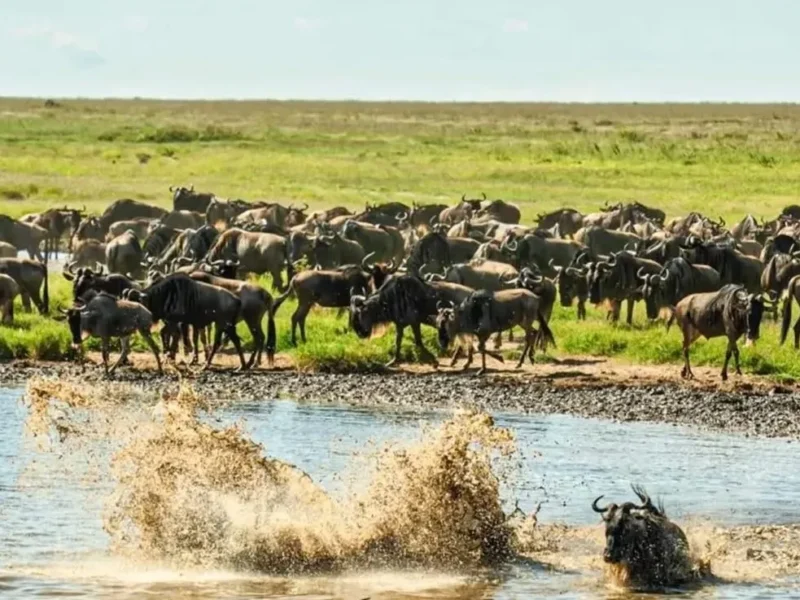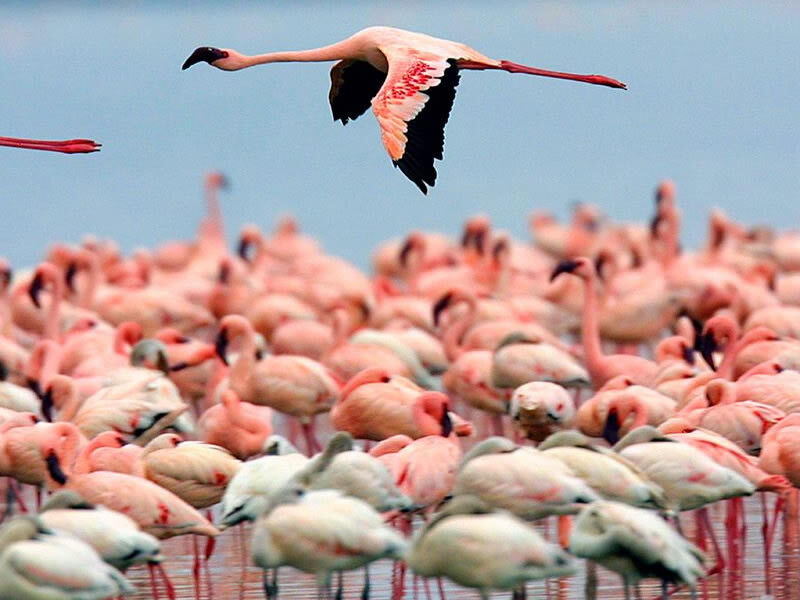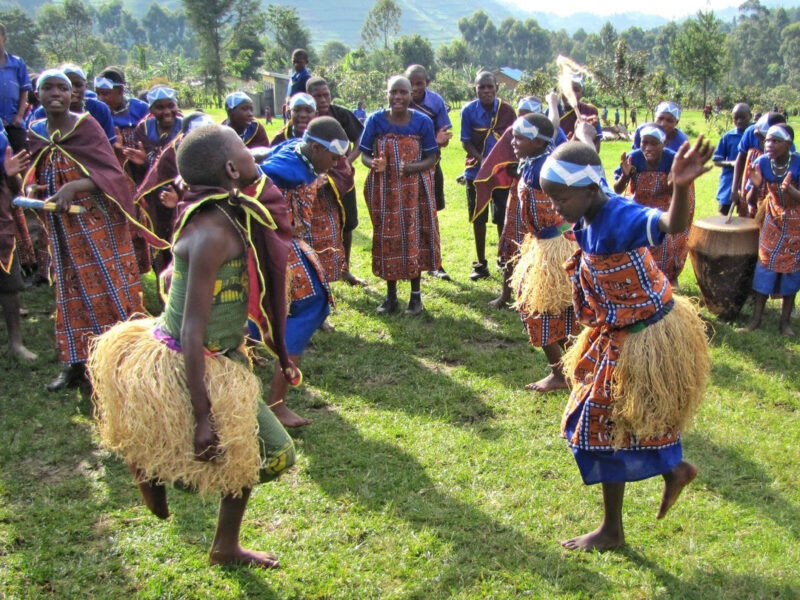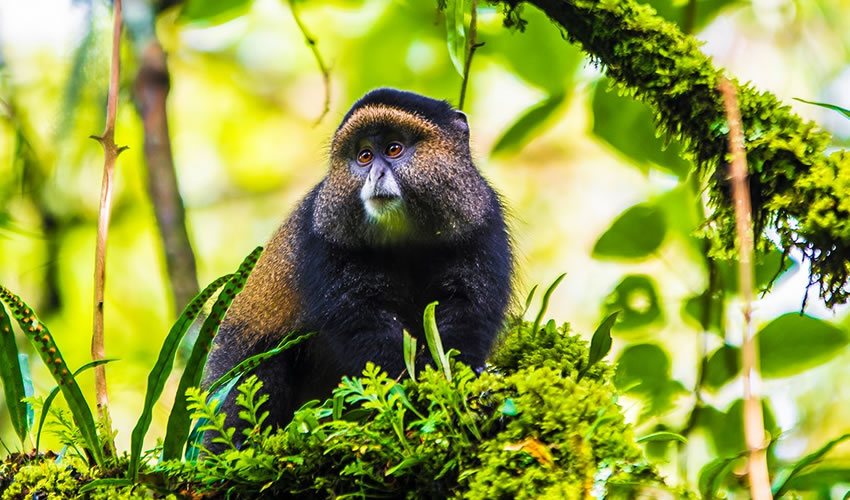
Golden monkeys in Uganda
April 11, 2025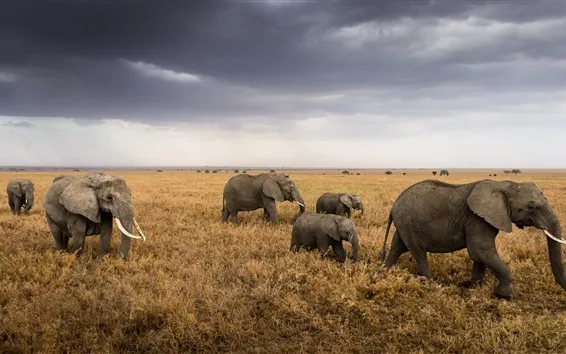
Elephants In Tanzania
April 11, 2025Lions In Tanzania
Overview of Lions in Tanzania
Tanzania is one of the best places in the world to see African lions in their natural habitat. Home to nearly a third of Africa’s remaining lion population, the country offers vast and protected landscapes where lions thrive. These majestic big cats are found across major parks like the Serengeti, Ngorongoro Crater, Tarangire, Ruaha, and Nyerere (formerly Selous) National Park.
Lions in Tanzania live in prides, consisting of related females, their cubs, and a few dominant males. They are social, powerful, and highly territorial animals. Female lions typically do the hunting, often targeting prey such as zebras, wildebeests, and buffalo.
Despite their strength and presence, lions face threats such as habitat loss, human-wildlife conflict, and poaching. Tanzania’s conservation programs, including protected parks, community partnerships, and research initiatives, play a crucial role in safeguarding their future.
Lions are not just a safari highlight—they are a national treasure and a key part of Tanzania’s natural and cultural heritage.
Lion Population in Tanzania
Overview
Tanzania is a critical stronghold for the African lion (Panthera leo) and is widely recognized as having the largest lion population in Africa. With its vast protected areas, diverse ecosystems, and long-standing conservation efforts, the country plays a leading role in the survival of this iconic species.
Population Estimates
– Tanzania is home to an estimated 15,000 to 16,000 lions, accounting for about one-third of all remaining lions in the wild globally.
– These lions are primarily found in the country’s extensive network of national parks, game reserves, and conservation areas.
This makes Tanzania not only a prime safari destination but also a priority nation for global lion conservation.
Where Lions Are Found in Tanzania
Lions in Tanzania are distributed across several major ecosystems, including:
– Serengeti National Park – One of the highest lion densities in the world.
– Ngorongoro Crater – A closed ecosystem with a stable but genetically limited lion population.
– Ruaha-Rungwa Ecosystem – Considered one of the largest lion habitats in Africa.
– Selous Game Reserve (now part of Nyerere National Park) – Supports a healthy population of lions in the south.
– Tarangire and Lake Manyara National Parks – Home to smaller but visible lion groups.
Genetic Diversity and Population Structure
While Tanzania has a large lion population overall, some sub-populations face genetic challenges:
– Ngorongoro Crater lions, for example, are relatively isolated and suffer from low genetic diversity due to inbreeding.
– Conservationists are studying ways to connect lion populations through wildlife corridors, allowing for better gene flow between groups.
Threats to Lion Populations
Despite strong numbers, lions in Tanzania face multiple threats:
1. Human-wildlife conflict – Lions may prey on livestock, leading to retaliation from local communities.
2. Habitat loss and fragmentation – As human settlements and agriculture expand, lion habitats shrink or become disconnected.
3. Poaching and illegal trade – Though less common than elephant poaching, lions are sometimes killed for body parts or trophies.
4. Inbreeding – Particularly in isolated areas like Ngorongoro, inbreeding can weaken population health over time.
Conservation Efforts in Tanzania
Tanzania has implemented various initiatives to protect and manage its lion population:
– National park protection: Over 30% of Tanzania’s land is protected, giving lions large, secure habitats.
– Community engagement: Conservation programs work with local people to reduce conflict and promote coexistence.
– Tourism funding: Revenue from safaris contributes to conservation and park management.
– Research and monitoring: Ongoing studies use GPS collars and camera traps to track lions and understand their behavior and needs.
Global Importance
As lion numbers decline across Africa, Tanzania remains a beacon of hope. Its stable and substantial lion population offers genetic diversity, ecological value, and a foundation for regional conservation efforts. Tanzania’s lions are not only central to African ecosystems but also to global efforts to save one of the planet’s most iconic predators.
Tanzania’s lion population is a national and global treasure. With continued conservation, community cooperation, and sustainable tourism, the country can ensure that future generations will still hear the roar of lions across its plains and forests. Protecting these big cats is not only about wildlife—it’s about preserving a vital part of Africa’s natural legacy.
Would you like this adapted into a fact sheet, infographic, or academic format? I’d be happy to assist!
Where Lions Live in Tanzania
Introduction
Tanzania offers one of the richest and most diverse natural environments in Africa, making it a prime habitat for African lions (Panthera leo). Lions in Tanzania live in a range of ecosystems—from vast savannahs to open woodlands, river valleys, and volcanic highlands. Thanks to the country’s extensive network of protected areas, lions have space to roam, hunt, and raise their young across multiple regions.
Location: Northern Tanzania, part of the Serengeti ecosystem
Habitat Type: Open plains, savannah grasslands, acacia woodlands
– The Serengeti is home to one of the largest lion populations in the world, with estimates of over 3,000 individuals.
– Lions here thrive due to the abundance of prey, especially during the Great Wildebeest Migration.
– The park’s vast open plains allow lions to form large prides, and visitors frequently witness dramatic hunting scenes and social behavior.
– This ecosystem also supports seasonal lion movements following the migration of prey animals between the Serengeti and Maasai Mara (Kenya).
2. Ngorongoro Crater (Ngorongoro Conservation Area)
Location: Adjacent to the Serengeti, Northern Tanzania
Habitat Type: Volcanic crater floor, grasslands, swamps
– The Ngorongoro Crater is a unique, self-contained ecosystem and one of the best places in Africa to observe lions up close.
– It has a resident population of about 50 to 60 lions that do not migrate, which makes sightings highly likely.
– However, due to the enclosed nature of the crater, genetic diversity is limited, and inbreeding has been a conservation concern.
– The lions here are known for their confidence and visibility, often seen lounging on crater walls or near herds of buffalo and wildebeest.
Location: Part of the Northern Circuit, southeast of Lake Manyara
Habitat Type: Dry savannah, baobab forests, riverine areas
– Tarangire is known for its large elephant populations, but lions are also commonly seen here, especially during the dry season.
– Lions often hunt near the Tarangire River, where herds of zebras, wildebeest, and antelopes gather for water.
– A unique behavior observed here is tree-climbing lions, which is relatively rare in most parts of Africa.
– The park’s open landscape and seasonal wildlife concentrations make it a rewarding place to spot lion activity.
Location: Central Tanzania, in the Southern Safari Circuit
Habitat Type: Semi-arid savannah, dry riverbeds, miombo woodlands
– Ruaha is part of the larger Ruaha-Rungwa ecosystem, one of the most important lion habitats in Africa.
– The park is estimated to hold more than 2,000 lions, making it one of the largest populations of lions in a single protected area.
– Ruaha is remote and less crowded, offering a wild, authentic safari experience.
– Lions in Ruaha frequently hunt large prey, including buffalo, giraffe, and even elephants, particularly during the dry season when water sources are limited.
5. Nyerere National Park (Formerly Selous Game Reserve)
Location: Southern Tanzania, along the Rufiji River
Habitat Type: River systems, woodlands, grasslands, swamps
– Nyerere is the largest national park in Tanzania and one of the richest in terms of biodiversity.
– It harbors a significant lion population, although the density is lower than in the Serengeti or Ruaha due to the vastness of the park.
– Lions here live in more varied habitats, including wetlands and riverine forests, and often hunt near the Rufiji River, which attracts many herbivores.
– This region is ideal for those seeking a more secluded, off-the-beaten-path safari experience with a high chance of spotting lions.
6. Other Areas Where Lions Are Found
– Lake Manyara National Park: Known for occasional sightings of tree-climbing lions and small prides.
– Katavi National Park: Remote and wild, in western Tanzania, with good lion sightings around floodplains and riverbeds.
– Mikumi and Saadani National Park: Smaller populations of lions exist here, offering more low-key safari experiences.
– Wildlife Management Areas (WMAs): Lions also roam outside national parks in community-managed conservation areas, especially those bordering larger parks like the Serengeti.
Why Habitat Matters
– Lions require large territories, abundant prey, and access to water.
– Their range and density vary depending on food availability, competition with other predators, and human activity.
– Protecting diverse habitats across Tanzania ensures that lions have the space and resources they need to survive.
Lions in Tanzania live across an incredible variety of landscapes—from the endless plains of the Serengeti to the hidden corners of Ruaha and the wetlands of Nyerere. This diversity of habitats not only supports a large lion population but also offers safari-goers unique experiences depending on where they travel. As long as these habitats are preserved and connected, Tanzania will remain a global sanctuary for lions for generations to come.
Lion Behavior and Social Structure in Tanzania
Introduction
Lions (Panthera leo) are among the most fascinating and social of all big cats, and observing them in the wild—especially in Tanzania—is a true highlight of any safari. Tanzania, home to the largest population of wild lions in Africa, offers an exceptional opportunity to witness their complex behavior, social dynamics, and natural instincts in action. Whether in the vast Serengeti plains or the remote wilderness of Ruaha, lions display behaviors that reflect both their ecological role and intricate social lives.
Social Structure: Life in a Pride
Unlike other big cats, lions are highly social and live in structured family groups called prides.
What Is a Pride?
– A pride typically consists of:
– 3 to 15 lionesses (related females)
– Their cubs
– 1 to 3 adult males (coalition males)
Roles Within the Pride:
– Females (Lionesses):
– Core members of the pride
– Usually stay with the same pride for life
– Take care of cubs collectively, often nursing each other’s young
– Do most of the hunting and raising of young
– Males (Coalition Males):
– May join a pride by taking it over from other males through battle
– Defend the pride and its territory from rival males
– Stay with a pride for about 2–4 years before being challenged and replaced
– Mate with females to produce offspring
– Cubs:
– Raised cooperatively by the pride’s lionesses
– Vulnerable to infanticide when new males take over a pride
Hunting and Feeding Behaviour
Hunting Strategies:
– Hunting is primarily done by females often as a group.
– Lions hunt cooperatively, using stealth and teamwork to stalk and ambush prey.
– Common prey includes wildebeests, zebras, gazelles, buffalo, and occasionally giraffes or young elephants.
Feeding Hierarchy:
– Once the prey is caught, there is a strict feeding order:
1. Males eat first, even if they didn’t participate in the hunt.
2. Females feed next
3. Cubs eat last
This can lead to aggressive interactions during feeding, especially when food is scarce.
Resting and Daily Activity
– Lions are primarily nocturnal, doing most of their hunting and socializing at night.
– They can sleep or rest for up to 20 hours a day, especially during the heat.
– Common daytime activities include grooming, playing, and bonding rituals within the pride.
Communication and Vocalization
Lions communicate through a variety of sounds and behaviors:
– Roaring – Can be heard up to 8 km (5 miles) away; used to mark territory and communicate across distances.
– Grunts, growls, moans, and purrs – Used for close-range communication.
– Scent marking – Males frequently mark trees and bushes with urine to establish territorial boundaries.
– Facial expressions and body language – Used to signal aggression, submission, or affection
Reproduction and Cub Rearing
– Mating can occur year-round, with peak birth seasons during times of prey abundance.
– After a gestation period of about 110 days, lionesses give birth to 1–4 cubs.
– Cubs are hidden for the first 4–6 weeks and introduced to the pride gradually.
– Multiple females may synchronize births and raise cubs communally, improving survival rates.
Territoriality and Conflict
– Lions are highly territorial, especially males.
– Territories can range from 20 to 400 square kilometers, depending on prey availability and competition.
– Males will fight to the death to defend or take over a pride.
– When new males take over, they may kill existing cubs to bring females back into heat.
Behavioral Variation Across Tanzania
Lion behavior can vary depending on habitat:
– Serengeti lions are more active during daylight in cooler months and hunt in large coordinated groups due to the abundance of migratory prey.
– Ngorongoro lions are more sedentary and bold due to the crater’s enclosed ecosystem and frequent contact with humans.
– Ruaha and Selous lions in southern Tanzania exhibit more elusive behavior due to the dense terrain and less human interaction.
Why Social Structure Matters
Understanding lion social dynamics helps conservationists:
– Monitor pride health and reproduction
– Track male coalitions and pride takeovers
– Detect early signs of stress or decline in populations
– Design better anti-poaching and community outreach programs
Lions in Tanzania live within a rich social world governed by cooperation, dominance, and survival instincts. Their complex behavior and strong family bonds make them not just fascinating to observe but essential to the balance of Tanzania’s ecosystems. Whether stalking prey on the Serengeti plains or resting under the baobabs of Tarangire, their lives reflect the raw beauty and intelligence of nature at its most majestic.
Certainly! Here’s a detailed write-up on the threats to lions in Tanzania, suitable for educational, conservation, or tourism awareness purposes:
Threats to Lions in Tanzania
Introduction
Tanzania is home to the largest population of wild lions in Africa, making it a critical stronghold for the species’ survival. However, despite strong conservation efforts and vast protected areas, lions in Tanzania face several serious threats that could impact their long-term survival. These challenges are primarily driven by human activities, ecological changes, and shifting land use patterns.
1. Human-Wildlife Conflict
What Happens:
– Lions sometimes prey on livestock, especially in areas near human settlements or grazing lands.
– In retaliation, pastoralists may poison, trap, or spear lions to protect their animals.
Where It’s Common:
– Around the borders of parks like Serengeti, Ruaha, and Ngorongoro, where human communities live close to lion habitats.
Why It’s a Problem:
– Retaliatory killings are one of the leading causes of lion mortality outside protected areas.
– It creates tension between conservation goals and community livelihoods.
2. Habitat Loss and Fragmentation
Causes:
– Expansion of agriculture, human settlements, road development, and livestock grazing.
– Increasing human population pressures lead to the conversion of wildlife corridors into farmland or villages.
Impact on Lions:
– Lions need large territories to hunt and breed.
– Habitat loss leads to isolated populations, making it harder for lions to find mates, prey, and safe living space.
– It increases encounters with humans and risks of conflict.
3. Poaching and Illegal Wildlife Trade
Types of Poaching:
-Lions are occasionally targeted for:
-Body parts (e.g., bones, claws, teeth) used in traditional medicine or sold as curios.
-Skins used as trophies or ceremonial attire.
Impact:
– While not as targeted as elephants or rhinos, lion poaching is increasing, often linked to the international illegal wildlife trade.
4. Disease and Genetic Challenges
Issues:
– In areas like the Ngorongoro Crater, lions suffer from inbreeding due to isolation.
– Outbreaks of diseases like canine distemper (transmitted from domestic dogs) have also affected lion populations.
Risks:
– Low genetic diversity weakens pride resilience to disease and environmental change.
– Disease outbreaks can quickly wipe out small or isolated populations.
5. Declining Prey Population.
Causes:
– Overgrazing by livestock, poaching of herbivores, and habitat degradation lead to reduced prey for lions.
– In some areas, prey competition with humans (e.g., bushmeat hunting) is a growing issue.
Consequences:
– When prey is scarce, lions may turn to livestock, increasing conflict with humans.
– Starvation and malnutrition can impact cub survival and reproductive success.
6. Climate Change
Effects:
– Alters rainfall patterns and water availability, affecting vegetation and prey abundance.
– Droughts can lead to competition over resources, increased mortality, and shifts in lion behavior.
Long-Term Impact:
– Climate change adds stress to already vulnerable ecosystems and may force lions to roam further, increasing risks of human contact.
7. Trophy Hunting (Controversial and Regulated)
Background:
– Trophy hunting of lions is allowed in some game reserves under strict regulation.
– Proponents argue it provides revenue for conservation and local communities.
Concerns:
– If not properly managed, it can disrupt pride dynamics, especially when dominant males are removed.
– Conservationists debate its ethical and ecological consequences.
Tanzania and its conservation partners are actively working to reduce these threats through:
– Community-based conservation: Empowering local people to protect lions while benefiting economically from eco-tourism.
– Wildlife corridors: Creating safe passages between protected areas to allow for lion movement and genetic diversity.
– Lion-proof bomas: Building reinforced livestock enclosures to prevent night-time lion attacks.
– Research and monitoring: Using GPS collars, camera traps, and field studies to track lion populations and identify threats.
– Education and awareness: Teaching communities the value of lions and how to coexist safely.
Lions are a national treasure and a global symbol of African wildlife, but they are facing real and growing threats. Human-lion conflict, habitat loss, poaching, and climate change all pose significant challenges to their future in Tanzania. However, with strong conservation efforts, community engagement, and continued support for protected areas, there is hope that Tanzania will remain a safe haven for lions for generations to come.


